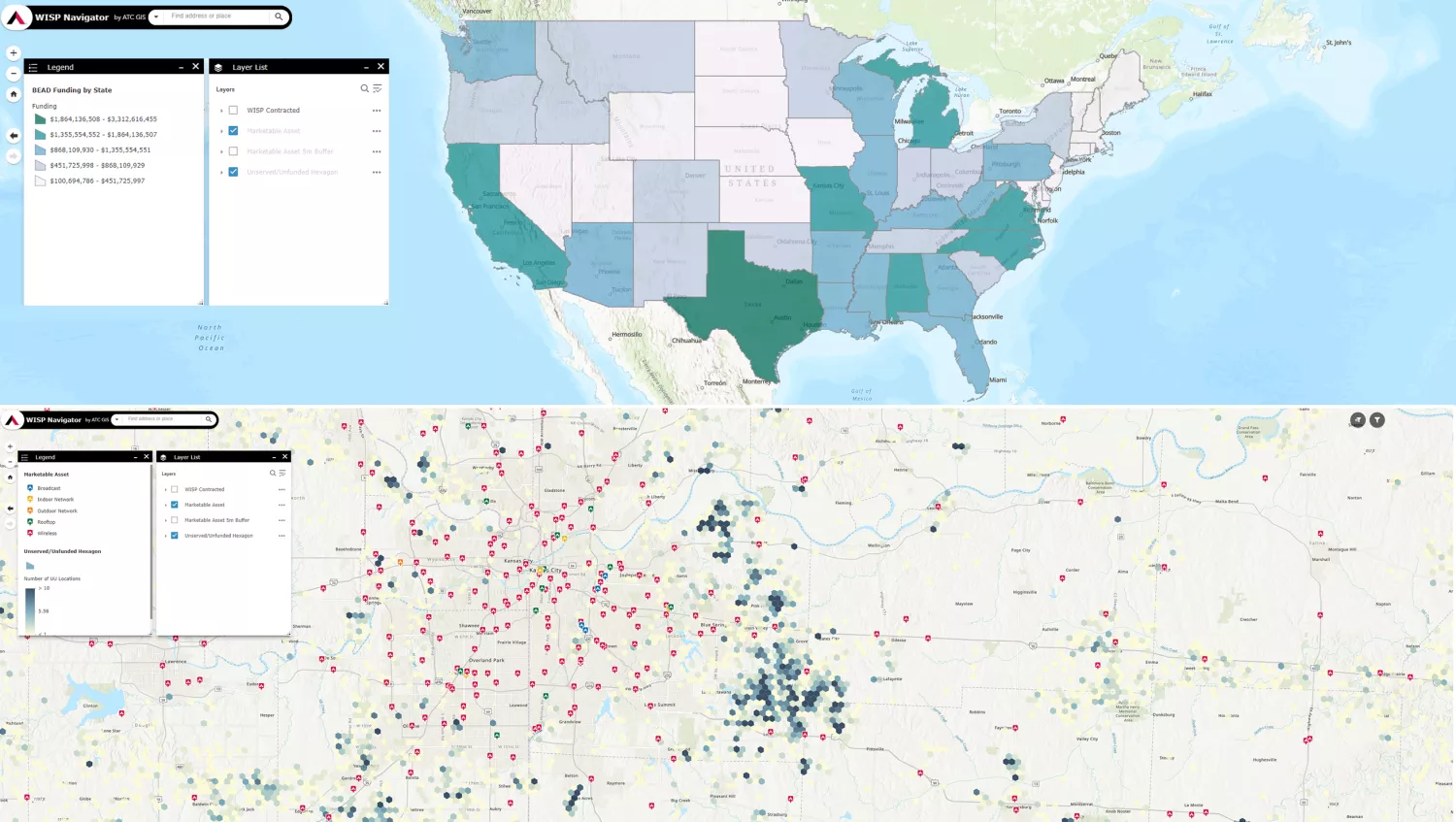American Tower works closely with Wireless Internet Service Providers (WISPs) across the country who leverage our deep portfolio of towers in rural and suburban towns. Our experienced teams and suite of tools help WISPs find the best sites for their network deployment plans. At a time when government funding is fueling new opportunities, what if WISP decisionmakers had a faster way to find the right towers, in the right locations, for unserved and underserved communities? In this blog, we answer frequently asked questions about our new tool for WISPs, which seeks to address these challenges.
As part of our ongoing mission to support WISPs in their quest to bring connectivity to rural communities, American Tower built a network planning tool. WISP Navigator, released at WISPAMERICA in Oklahoma City in March 2024, is a unique resource with many use cases to help WISPs simplify and speed deployment, whether for the development of a new network or the enhancement of an existing one.
A recent use case for the new tool is the current Broadband Equity Access and Deployment (BEAD) program, whereby this new application identifies BEAD-eligible locations in proximity to our towers. Other use cases include applying network expansion theories through the lens of the Rural Digital Opportunity Fund (RDOF), Connect America Fund (CAF), and other state or local government stimulus programs. The utilization of the tool doesn’t stop here; it can help answer many network planning questions. Overall, American Tower seeks to help WISPs find the customers who could be serviced by these programs to bridge the digital divide, as well as provide guidance in general network planning. Through a custom one-on-one consultation, we offer a view into a series of mapping layers to assist in decision making, including, but not limited to, a viewshed analysis with tower sites available in our portfolio.
Below we address some questions WISPs may have when considering the new tool and the benefits of our personalized consultation.
1. What is WISP Navigator and how does it benefit WISPs?
Speed to revenue is a business imperative and aligns well with the needs of those living in rural communities. American Tower has approximately 26,000 towers in rural and suburban areas, with varying coverage to underserved communities. A tool that efficiently identifies those towers with the greatest customer reach is valuable to WISPs, as they seek to quickly generate return on investment. WISPs that deliver Fixed Wireless Access (FWA), or both fiber and FWA, will find opportunities to leverage the tool. American Tower, through the power of WISP Navigator, can be an asset in helping WISPs in their mission to serve the unserved with network planning services in the near and long term.
2. How does WISP Navigator differ from Site Locator?
Our long-standing Site Locator tool, which is one of the features of an American Tower Account, is a self-service platform for network operators of all types, including WISPs, Mobile Network Operators, and other telecommunications providers, to find sites in our portfolio. Site Locator will continue to be available for use by all operators. It leverages mapping technology to lay out where our tower sites are in geographic areas. One can search sites by coordinates, address, or customized search areas and identify sites on the go with our mobile application.
The new WISP Navigator tool is a full-service platform, specifically built for the WISP community, that assists with network planning. WISP Navigator is only available for WISPs by scheduling a one-on-one meeting with me or one of my teammates. It leverages similar mapping technology for viewing the sites in our portfolio, but also offers additional layers and data sets pertinent to WISPs. It provides custom data visualization that helps WISPs quickly identify towers in unserved and underserved locations.
3. What are the tool’s features and functionalities that benefit WISPs?
We know WISPs have multiple considerations when analyzing the value of an American Tower asset, such as assessing if the height of our tower is taller than nontraditional structures, like water towers, and understanding other terrain considerations. In the first use case mentioned, BEAD funding opportunities add a new element to the calculus–awareness of unserved and underserved locations as defined by the National Telecommunications and Information Administration (NTIA).
WISP Navigator offers:
- Tower Locations and Specifications: Details any contracted towers with us and all other American Tower assets, with heights and availability.
- FCC Broadband Funding Map Data: Identifies unserved and underserved locations near service areas. Our team can help validate or further refine your analysis of this third-party data, which will be revised as the FCC updates its maps.
- Viewshed Analysis: Offers terrain considerations and other geospatial insights.
During our consultation, I’ll review the various options for data layering and can provide valuable information, whether you’re planning to leverage existing funding opportunities or not. Tell me where you’re looking to expand coverage and I can provide insights for expansion opportunities. By working more closely together, through the collaboration offered by this tool, American Tower can help WISPs in unique and creative ways to meet broadband market demands. We’re regularly gathering feedback from our customers on the tool and iterating on the features and functionality that would best serve them.
4. How do I get access to the tool?
WISP Navigator is available during a one-on-one consultation with a WISP team member, like me. We aim to provide a personalized experience to help you understand this exciting new resource and how it can help build out a broadband network that meets your business objectives, budgets, and timelines.
Sign up for a personalized 30-minute consultation with me, or a member of my team, to learn more.

Ben Gleason
For the past four years, Ben has been focused on providing exceptional customer service and supporting business development initiatives. Today, he’s dedicated to helping WISPs across the U.S. achieve their business goals.












